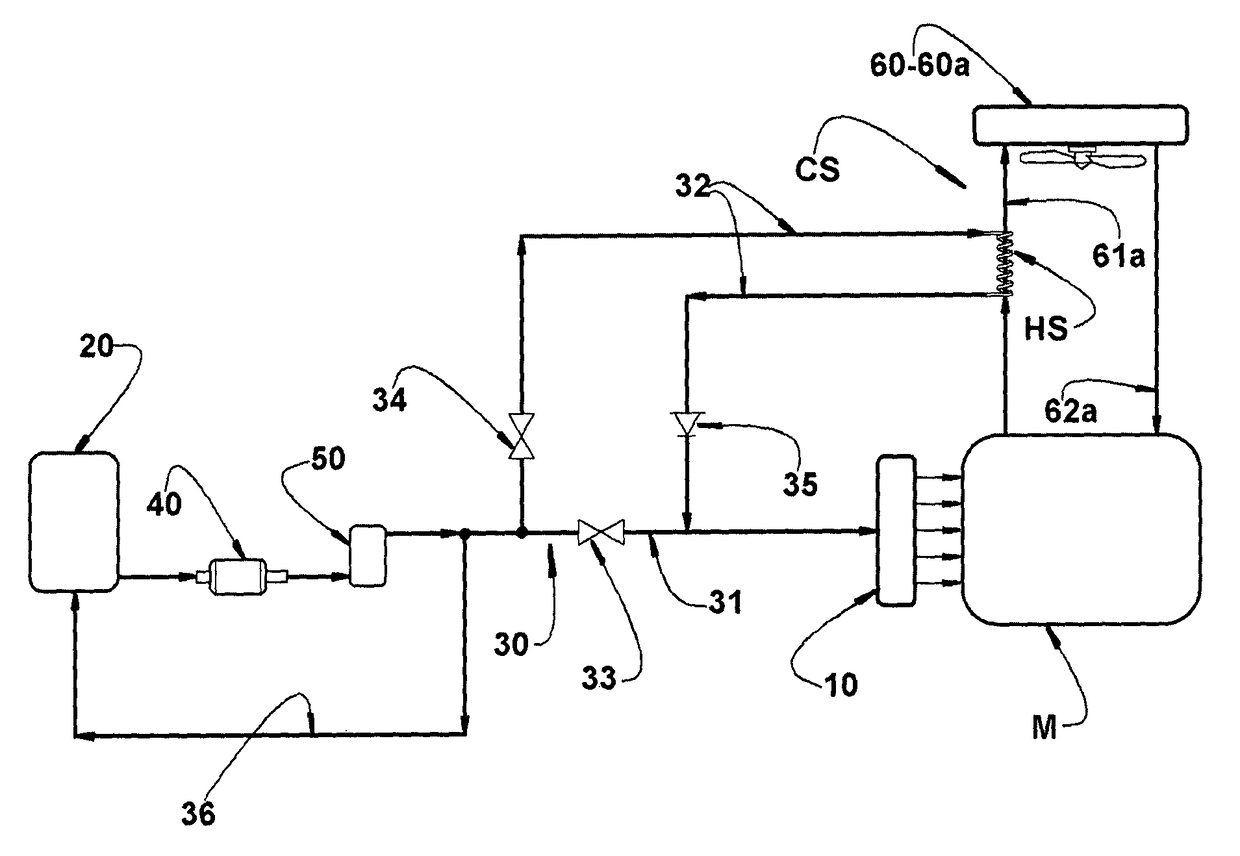Thermal management system for the feeding of fuel in internal combustion engines
a technology of management system and internal combustion engine, which is applied in the direction of mechanical equipment, fuel injection apparatus, and thermal treatment of fuel, etc., can solve the problems of high pollution level, discharge of vehicle battery after a few successive starts, and damage to the environment, so as to reduce fuel consumption and improve engine efficiency , the effect of reducing damag
- Summary
- Abstract
- Description
- Claims
- Application Information
AI Technical Summary
Benefits of technology
Problems solved by technology
Method used
Image
Examples
first embodiment
[0044]In said first embodiment, the fuel feed line 30 comprises a first segment 31, directly connected to the injection system 10 and provided with a first valve 33, and a second segment 32 which defines a by-pass to the first segment 31 and which is located in order to absorb thermal energy from a heat source HS defined by the hot fluid, in the form of hot cooling water, which is taken, through the hot fluid duct 61a, to the heat exchanger 60 defined by the radiator 60a.
[0045]The second segment 32 of the fuel feed line 30 is provided with a second valve 34, located upstream the heat source HS, and with a one-way valve 35 located downstream said heat source HS.
[0046]The thermal energy absorption from the heat source HS may be carried out in different ways, such as, for example, by winding an extension of the second segment 32 of the fuel feed line 30 around the hot fluid duct. 61a leading to the heat exchanger 60 which, in FIG. 1, is defined by the radiator 60a. This construction i...
second embodiment
[0052]In FIG. 2 of the attached drawings it is illustrated, a second embodiment for the present management system, when applied to an engine M presenting the same basic characteristics already described in relation to the engine represented in FIG. 1 and which are presented with the same reference numbers.
[0053]In said second embodiment, the engine M is provided with a cooling system CS which uses a heat exchanger 60, in the form of an oil radiator 60b, and a cooling fluid defined by the lubricant oil of the engine M and which circulates, by means of a hot fluid duct 61b and a cooled fluid duct 62b, through parts of the engine M and through the heat exchanger 60.
[0054]As already described above in relation to the construction of FIG. 1, in the construction of FIG. 2 the fuel feed line 30 comprises the same first and second segments 31, 32 located in the same manner and also provided with a first valve 33, a second valve 34 and a one-way valve 35, which operate according to the tempe...
third embodiment
[0059]In FIG. 3 of the attached drawings is illustrated a third embodiment for the present management system, when applied to an engine M presenting the same basic characteristics already described in relation to the engine represented in FIGS. 1 and 2 and which are identified with the same reference numbers.
[0060]In said third embodiment, the engine M is provided with a cooling system CS which uses a heat exchanger 60, in the form of a double radiator, of water and oil, built to simultaneously receive a flow of the lubricant oil from the engine M, a flow of cooling fluid, usually water based, and also a flow of fuel to be supplied to the injection system 10 of the engine M.
[0061]In this third embodiment the cooling of the engine M is carried out by the circulation of water through the heat exchanger 60, through a hot fluid duct 61a and through a cooled fluid duct 62a, both ducts allowing the water to leave the engine M through the hot fluid duct 61a, through the double radiator 60c...
PUM
 Login to View More
Login to View More Abstract
Description
Claims
Application Information
 Login to View More
Login to View More - R&D
- Intellectual Property
- Life Sciences
- Materials
- Tech Scout
- Unparalleled Data Quality
- Higher Quality Content
- 60% Fewer Hallucinations
Browse by: Latest US Patents, China's latest patents, Technical Efficacy Thesaurus, Application Domain, Technology Topic, Popular Technical Reports.
© 2025 PatSnap. All rights reserved.Legal|Privacy policy|Modern Slavery Act Transparency Statement|Sitemap|About US| Contact US: help@patsnap.com



